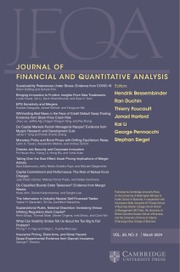Article contents
Filing Agents and Information Leakage
Published online by Cambridge University Press: 14 March 2025
Abstract
Filing agents—intermediaries used by 80% of U.S. firms—are associated with leakage of information that affects stock prices. Prior to the public release of a securities filing, most firms outsource the final processing and submission of the filing to a third-party filing agent. We find leakage is higher when firms use filing agents than when firms self-file, particularly pre-2018. Leakage is greater when the private information is more valuable and decreases when firms switch to self-filing. Our research suggests filing agents, and a firm’s choice to use them, are an important, understudied channel for the leakage of private information.
Information
- Type
- Research Article
- Information
- Creative Commons
- This is an Open Access article, distributed under the terms of the Creative Commons Attribution licence (http://creativecommons.org/licenses/by/4.0), which permits unrestricted re-use, distribution and reproduction, provided the original article is properly cited.
- Copyright
- © The Author(s), 2025. Published by Cambridge University Press on behalf of the Michael G. Foster School of Business, University of Washington
Footnotes
We are grateful for helpful comments from Dave Denis, Will Gerken, Russell Jame, and conference participants at the 2019 Financial Research Association annual meeting (early idea session) and seminar participants at the University of Kentucky and the University of Alabama.
References
- 1
- Cited by

